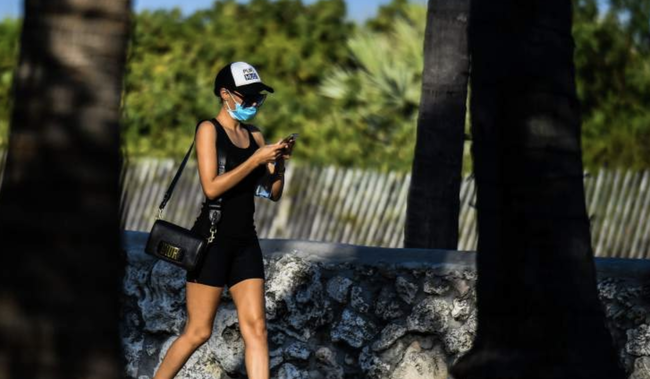Some Optimism From Goldman: The Number Of New COVID Cases Is Starting To Flatten Tyler Durden Fri, 07/24/2020 - 12:05
As the US reports more than 1k deaths for the third straight day, reporters are mostly focusing on this milestone, along with the US surmounting the 4 million-case mark, as the biggest COVID-19-related stories of the day. But a team of market-focused analysts at Goldman Sachs pointed out that the daily case totals in some of the worst hit Sun Belt states appear to have finally plateaued.
Earlier, Texas Gov Greg Abbott sat for an interview with Joe Kernen and Andrew Ross Sorkin during the first hour of CNBC's "Squawk Box" where he argued that social distancing measures and the closure of bars etc undertaken in his state are working, before pleading with viewers to please wear a mask in public.
"Let me be very clear we do not want to shutdown again. The only way we can go about the process of not shutting down is for people to embrace this process of wearing a face mask," says @GregAbbott_TX on #COVID19. pic.twitter.com/6NDkONcNWK — Squawk Box (@SquawkCNBC) July 24, 2020
Though the tone of most of the media coverage might suggest otherwise, Abbott insisted that Texas has definitively passed its infection peak, and that Texans must continue to assiduously follow the government's advice if they want to see the outbreak dissipate.
As it turns out, Abbott has gotten some unexpected help from a team of analysts at Goldman Sachs, who argued in their latest COVID-19 daily US update that there are reasons for optimism, even as Paul Krugman opines that Italy's handling of its coronavirus response has outshone the US, despite the fact that Italy's case-fatality rate and deaths per 100k people rate were both higher than in the US, according to Johns Hopkins Data.
Anyway, as the team from Goldman writes, it looks like some of the worst-hit states are finally seeing their case numbers plateau, eve as the national new-case numbers continue to trend higher (looking at the 7-day average).
And while the GS team noted that governors are probably still "reluctant to push forward" with reopening measures, the time to reimpose sweeping lockdowns appears to have come and gone.
* * *
The number of new cases per day is very high but apparently flattening in a few states that experienced significant virus resurgence over the past week, including Arizona, Florida, and South Carolina. Meanwhile, the number of new cases per day is elevated and surging higher in a handful of other states including Nevada, Alabama, Louisiana, Mississippi, Idaho, and Tennessee. Nationally, new cases continue to rise further on average and remain on upward trajectories in a majority of states.
Hospitalizations and fatalities also continue to rise further nationally and sharply in some states. In Louisiana, some hospitals have halted non-emergency surgeries in order to increase available capacity to accommodate greater numbers of COVID-19 patients.
The average number of the four gating criteria the federal government recommends to proceed with reopening that states are meeting has risen over the past few days as prevalence of COVID-like illness symptoms has declined in several states, potentially suggesting downward pressure on case growth. But with the level of new cases already very high in several states and on average nationally, state government officials may remain reluctant to push forward with reopening.
The number of new cases per day is very high but apparently flattening in a few states that experienced significant virus resurgence over the past week, including Arizona, Florida, and South Carolina. Meanwhile, the number of new cases per day is elevated and surging higher in a handful of other states including Nevada, Alabama, Louisiana, Mississippi, Idaho, and Tennessee. Nationally, new cases continue to rise further on average and remain on upward trajectories in a majority of states.
Hospitalizations and fatalities also continue to rise further nationally and sharply in some states. In Louisiana, some hospitals have halted non-emergency surgeries in order to increase available capacity to accommodate greater numbers of COVID-19 patients.
The average number of the four gating criteria the federal government recommends to proceed with reopening that states are meeting has risen over the past few days as prevalence of COVID-like illness symptoms has declined in several states, potentially suggesting downward pressure on case growth. But with the level of new cases already very high in several states and on average nationally, state government officials may remain reluctant to push forward with reopening.
* * *
Source: Goldman Sachs
http://dlvr.it/RcHy4R

No comments:
Post a Comment